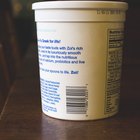Kefir is a bubbly fermented drink similar to yogurt, made when probiotic bacterial cultures called kefir grains interact with and ferment milk. If you have bulk kefir, you can freeze the drink for later consumption. Freezing does not kill the beneficial probiotics in kefir; they simply go dormant until thawed and consumed. Similar to freezing milk, the solids and whey in kefir will separate in the freezing process, but you simply shake the thawed kefir to reincorporate.
Pour the kefir in moisture-vapor resistant containers, such as freezer bags or plastic freezer storage containers, leaving one-half-inch of head space at the top for a pint of kefir, 1 inch for a quart of kefir or 1 1/2 inches for a gallon container. If the container has a narrow opening, provide 1 1/2 inches of head space at the top regardless of the amount of kefir.
Remove as much air from the containers as possible and seal the containers or bags tightly to prevent air from damaging the kefir. Label the containers with the date of freezer storage and the freezer expiration date, about 3 months after freezing. Write directly on the container or bag with a permanent marker or make a label using a piece of freezer tape.
Place the kefir containers against the walls of the freezer, where the temperature is coldest, so the kefir freezes as quickly as possible. Damage from moisture and vapor is less likely to occur when the kefir is frozen fast. Leave them against the walls for about 24 hours or until frozen solid, then move the containers anywhere in the freezer if you wish.
Remove the kefir container from the freezer and place it in the refrigerator to thaw at least 24 hours before you plan to drink it. Thawing time depends on the type of packaging; a gallon of kefir frozen in a solid block inside a plastic storage container takes considerably longer to thaw than a pint of kefir stored flat in a freezer bag.
Related Articles

Why Does Greek Yogurt Have More Protein ...

How to Freeze Goat's Milk

How to Make Wine in a Gallon Jug

Can I Freeze Milkshakes?

How to Use a Slush Mug

How to Freeze Croissants

How to Freeze Chunks of Butternut Squash

How to Ferment Milk

How to Keep Grated Parmesan Cheese a ...

Can You Freeze Raw Oysters?

Kefir Substitute

Why Does Milk Freeze in the ...

How to Freeze Greek Yogurt

Can You Freeze Meat Twice?

Can You Drink Milk That Expires the ...
Does Sour Cream Go Bad if Unopened?

Does Brandy Freeze?

Does Caviar Go Bad?
How to Freeze Papaya

How to Purchase Milk Crates
References
- National Center for Home Food Preservation: Freezing Animal Products
- National Center for Home Food Preservation: Freezing Prepared Foods
- The Kitchn: Got (Too Much) Milk? Freeze It for Later!
- The Kitchn: Good Tip: Freezing Leftover Buttermilk
- Handbook of Fermented Functional Foods, Second Edition: Edward R. Farnworth
- Food Product Design: Deliciously Frozen Probiotics -- Ice Cream and Beyond
Tips
- As long as freezer bags are sealed tightly to prevent leaks, you can lay them flat in the freezer and stack several on top of each other to save space in the freezer.
- While you can freeze kefir beyond three months, other flavors and odors within the freezer might affect the kefir.
Writer Bio
A former cake decorator and competitive horticulturist, Amelia Allonsy is most at home in the kitchen or with her hands in the dirt. She received her Bachelor's degree from West Virginia University. Her work has been published in the San Francisco Chronicle and on other websites.